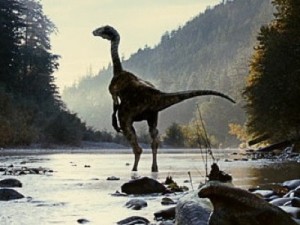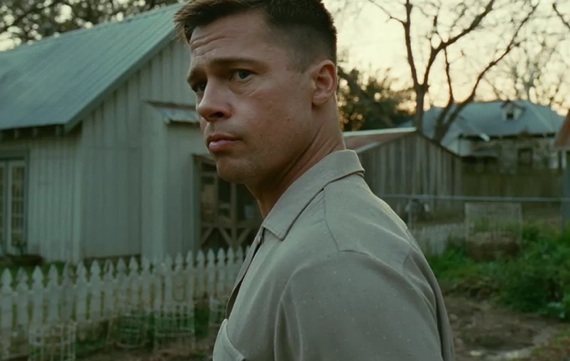Fuse Film Review: The Tree of Life — Lofty, Dreamy, and Personal
There are wonderful, beautiful things about The Tree of Life. But despite being innovative and important, despite inspiring awe, it envisions a kind of transcendent greatness that it itself does not quite embody.
Tree of Life. Directed by Terrence Malick.
By Taylor Adams.
Nothing if not prophetic, director Terrence Malick quotes from The Book of Job at the beginning of his film The Tree of Life: “Where were you when I laid the earth’s foundation, while the morning stars sang together and all the angels shouted for joy?”
Well, you were in the theater, watching Malick kick start the universe in a spectacular space-symphony. This, and the juxtaposition of the infinite and spiritual with an otherwise quiet family tale of American 1950’s suburbia, the latter dreamily recollected by that family’s eldest son.
The whole mostly-beautiful, sometimes puzzling morass constitutes a pensive meditation on the intersection of the timeless and the mundane—at least within the subjectivity of one man and one film director. The result is a film that’s difficult to classify, much less evaluate. How much you enjoy it may have a lot to do with what, exactly, you desire from a movie.
Most films tell a story. Some do so with a pensive, visual flair, as did Malick in earlier efforts, especially Days of Heaven and The Thin Red Line. The Tree of Life goes further, reaching for pure lyricism, natural beauty, and insinuated meaning.
Like a lot of good poetry, The Tree of Life isn’t as much concerned with accessible storytelling as it is with arranging daubs of this family tale, by way of Jack’s childhood memory, onto a beautifully composed and intermittenly moving canvas.
Breathless passages where the lilting, swooping camera brings you on a dreamy ride through Malick’s world give way to galactic explosions and prehistoric fantasies. They do this easily, without explicit narrative provocation, and maybe without purpose. For a while, it’s an amazing ride.
The American family Malick’s poem swirls around is the O’Briens. At first glance they seem intended to typify, even caricature, early suburbia: a strict father (Brad Pitt); a kindhearted, religious mother (Jessica Chastain); and three sons.
The eldest, Jack, is played in middle-age by Sean Penn and in youth by Hunter McCracken. He is the daydreaming architect to whom we ostensibly owe thanks for the lyrical childhood memories and pensive musings that make up much of The Tree of Life’s free-roaming narrative.
The flood of memories seems to follow reflections on unresolved feelings concerning the death of one of his brothers at 19 and the pain it caused his family. From here we are taken on a journey through his childhood. Some memories are happy, joyful, but increasingly they become agonized as Jack’s insecurities, periods of youthful rebellion, and issues with Pitt’s proud taskmaster of a father take center stage.
But not before Malick takes a detour to show us all of pre-history in a long, operatic sequence of cosmic explosions and stardust accompanied by an impressive repertoire of classical music (which persists throughout the film. Brad Pitt’s character is the type to get up from the dinner table and lovingly yell “Brahms!” to his record player while his son tries to talk to him). The planet is formed and erupts with volcanic activity. The primordial soup teems with bacterial life. Dinosaurs walk the earth, eons pass, and then we jump a few million years to the tale of the O’Briens.
These solar sequences, seemingly choreographed to the music, raise comparisons to Stanley Kubrick’s 2001: A Space Odyssey. The stylistic similarities are not coincidental: Douglas Trumbull, who as a young man served as lead special effects supervisor on Kubrick’s film, contributed to the effects on Malick’s. But what’s also interesting is that these similar sequences serve different ends. For Kubrick, the majesty of the heavens, the incomprehensible nature of the infinite, inspires the exploratory drive of mankind.
For Malick, space is more literally heavenly. The sequences in context seem highly spiritual—even if the creation depicted is firmly guided by science rather than the hand of God. The light shows place the suburban events of the rest of the film into an ambigious perspective that somehow trivializes them while simultaneously imbuing them with a kind of metaphysical significance.
What, exactly, that significance might be is not explicit. Religious themes are important to the characters (sparse dialog and voiceover make this clear), but the film itself doesn’t necessarily share these preoccupations as much as it is interested in human philosophy and spirituality. As The Tree of Life dreamily weaves between images spectacular and mundane, past and present, it allows, even asks, for your subjective interpretation. It’s an admirable achievement, rewarding thoughtful viewers and possibly alienating others.
Unfortunately, when this journey gives way, in much of the film’s third act, to a more focused exploration of Jack’s childhood, the magic threatens to evaporate into confusion. Confusion for us—as the style of this section is noticeably more restrained—but more confusion for the film, which has endeavored so hard to be one thing and then becomes, much less effectively, quite another.
This more conventional narrative turns away from the existential themes related to the loss of a brother towards a psychological exploration of paternal relationships. The conflict of style and substance between this segment of the film and the others is puzzling and somewhat lessens the cinematic spell. While an exploration of the interior dynamics of the family and of Jack himself is compelling, something about how it is strong armed into the film, in terms of pacing and square-jawed style, ironically renders the most plot-heavy, and thus conventional, portions of the film the least interesting.
When Malick is at his best, he takes us on a journey: a visual feast accompanied by a quietly profound story. When The Tree of Life is on this level, it feels like an invitation to a near-spiritual cinematic journey. At times, though, it feels more like we’re just dragged along for the cosmic ride.
The film has been attacked by some critics for being pretentious. I fear this criticism is based more on some audiences’ inability to enjoy anything not full of explosive pacing and explicit meanings and narrative closure, etc. But if it’s also based on the fact that this film becomes alarmingly personal to the filmmaker, the detractors have a point.
This is Malick’s style taken to its logical conclusion: so lofty and dreamy as to be over our heads. Not because we cannot understand, but because it’s so firmly within his own.
There are wonderful, beautiful things about The Tree of Life. But despite being innovative and important, despite inspiring awe, it deals with a level of transcendent greatness that it itself does not quite reach.
Any measure of great art is a very subjective, personal thing, but what makes it transcendent are the fleeting moments in which truths are revealed to us in such a way that we feel we’ve always known. Some might say they find The Tree of Life to be that kind of film, but others may be able to extract little. Both would have a point, but the film is art all the same—art that deserves to be seen, and that you deserve to see.



